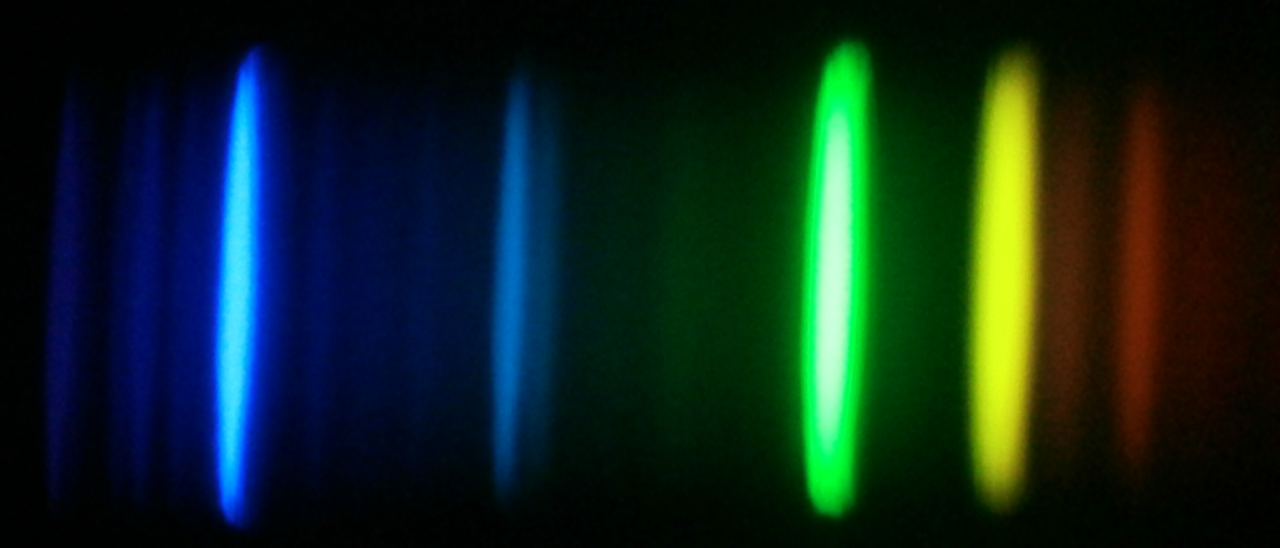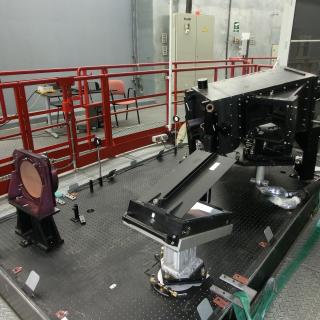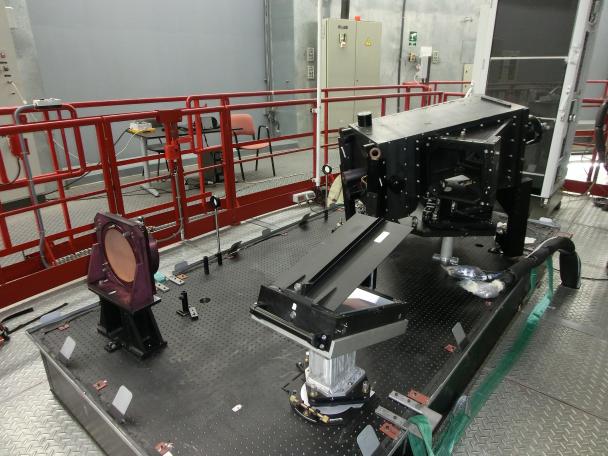Grants related:
General
Stellar spectroscopy allows us to determine the properties and chemical compositions of stars. From this information for stars of different ages in the Milky Way, it is possible to reconstruct the chemical evolution of the Galaxy, as well as the origin of the elements heavier than boron, created mainly in stellar interiors. It is also possible to study stellar formation, and the formation of the Galaxy, from the signature of the Galactic potential on the stellar orbits, and the distributions of mass, ages, and the abundance of heavy elements.
Obtaining high-resolution spectra, as necessary for studies of chemical compositions, requires advanced and efficient instrumentation. This is particularly true for research that calls for large stellar samples, which demands the observation of hundreds or thousands of sources simultaneously. Efficiency requires that the data processing and analysis are performed in an automated way.
The interpretation of spectra is based on physical models of the atmospheres of the stars, from where the light that we observe escapes the stars. The main ingredients for building such models are the fluid dynamics, and the properties of the atoms, ions, and molecules, especially regarding their interactions with the radiation coming from the stellar interior.
Once we have a plausible model, it is possible to compute in detail how the radiation propagates through the stellar atmosphere, and the emergent spectrum, which can then be iteratively compared with the observations to refine the model.
This project covers three different research fronts:
- Improving model atmospheres and simulations of stellar spectra.
- Developing tools for acquisition, reduction, and analysis of spectroscopic observations, in particular for the determination of chemical abundances in stars.
- Designing, preparing, and executing spectroscopic studies of stars aimed at understanding a) the most relevant aspects of the physics of stellar atmospheres, b) the formation and evolution of stars, c) the origin of the chemical elements, and d) the formation, structure, and evolution of the Milky Way galaxy.
Members
Results
- Complete the installation and commissioning of HORuS on GTC
- Discover two new stars with more than 100,000 times less iron than the Sun
- Complete the classification of all the APOGEE spectra with K-means
- Publish a complete collection of model stellar spectra for stars O to M
- Identify the signature of chemical diffusion in the atmospheres of the stars in the cluster M67
Scientific activity
Related publications
-
The Gaia-ESO Survey: chemical signatures of rocky accretion in a young solar-type star
It is well known that newly formed planetary systems undergo processes of orbital reconfiguration and planetary migration. As a result, planets or protoplanetary objects may accrete onto the central star, being fused and mixed into its external layers. If the accreted mass is sufficiently high and the star has a sufficiently thin convective
Spina, L. et al.Advertised on:
102015 -
Abundances, Stellar Parameters, and Spectra from the SDSS-III/APOGEE Survey
The SDSS-III/Apache Point Observatory Galactic Evolution Experiment (APOGEE) survey operated from 2011–2014 using the APOGEE spectrograph, which collects high-resolution (R ∼ 22,500), near-IR (1.51–1.70 μm) spectra with a multiplexing (300 fiber-fed objects) capability. We describe the survey data products that are publicly available, which include
Holtzman, J. A. et al.Advertised on:
112015 -
The Eleventh and Twelfth Data Releases of the Sloan Digital Sky Survey: Final Data from SDSS-III
The third generation of the Sloan Digital Sky Survey (SDSS-III) took data from 2008 to 2014 using the original SDSS wide-field imager, the original and an upgraded multi-object fiber-fed optical spectrograph, a new near-infrared high-resolution spectrograph, and a novel optical interferometer. All of the data from SDSS-III are now made public. In
Alam, S. et al.Advertised on:
72015 -
The Gaia-ESO Survey: Empirical determination of the precision of stellar radial velocities and projected rotation velocities
Context. The Gaia-ESO Survey (GES) is a large public spectroscopic survey at the European Southern Observatory Very Large Telescope. Aims: A key aim is to provide precise radial velocities (RVs) and projected equatorial velocities (vsini) for representative samples of Galactic stars, which will complement information obtained by the Gaia astrometry
Jackson, R. J. et al.Advertised on:
82015 -
Chemical Cartography with APOGEE: Metallicity Distribution Functions and the Chemical Structure of the Milky Way Disk
Using a sample of 69,919 red giants from the SDSS-III/APOGEE Data Release 12, we measure the distribution of stars in the [α/Fe] versus [Fe/H] plane and the metallicity distribution functions (MDFs) across an unprecedented volume of the Milky Way disk, with radius 3 < R < 15 kpc and height | z| \lt 2 kpc. Stars in the inner disk (R < 5 kpc) lie
Hayden, M. R. et al.Advertised on:
82015 -
A New sdO+dM Binary with Extreme Eclipses and Reflection Effect
We report the discovery of a new totally eclipsing binary (R.A. = {06}{{h}}{40}{{m}}{29}{{s}}11; decl. = +38°56‧52″2 J = 2000.0; Rmax = 17.2 mag) with an sdO primary and a strongly irradiated red dwarf companion. It has an orbital period of Porb = 0.187284394(11) day and an optical eclipse depth in excess of 5 mag. We obtained 2 low-resolution
Derekas, A. et al.Advertised on:
82015 -
An equatorial ultra iron-poor star identified in BOSS
We report the discovery of SDSS J131326.89-001941.4, an ultra iron-poor red giant star ([Fe/H] ≃ -4.3) with a very high carbon abundance ([C/Fe] ≃ +2.5). This object is the fifth star in this rare class, and the combination of a fairly low effective temperature (Teff ≃ 5300 K), which enhances line absorption, with its brightness (g = 16.9), makes
Ge, J. et al.Advertised on:
72015 -
Rapid Rotation of Low-mass Red Giants Using APOKASC: A Measure of Interaction Rates on the Post-main-sequence
We investigate the occurrence rate of rapidly rotating (v{sin}i >10 km s‑1), low-mass giant stars in the Apache Point Observatory Galaxy Evolution Experiment-Kepler (APOKASC) fields with asteroseismic mass and surface gravity measurements. Such stars are likely merger products and their frequency places interesting constraints on stellar population
Stello, D. et al.Advertised on:
72015 -
Young α-enriched giant stars in the solar neighbourhood
We derive age constraints for 1639 red giants in the APOKASC sample for which seismic parameters from Kepler, as well as effective temperatures, metallicities and [α/Fe] values from APOGEE DR12 (Apache Point Observatory Galactic Evolution Experiment Data Release 12) are available. We investigate the relation between age and chemical abundances for
Martig, M. et al.Advertised on:
82015 -
Deep SDSS optical spectroscopy of distant halo stars. II. Iron, calcium, and magnesium abundances
Aims: We analyze a sample of 3944 low-resolution (R ~ 2000) optical spectra from the Sloan Digital Sky Survey (SDSS), focusing on stars with effective temperatures 5800 ≤ Teff ≤ 6300 K, and distances from the Milky Way plane in excess of 5 kpc, and determine their abundances of Fe, Ca, and Mg. Methods: We followed the same methodology as in the
Fernández-Alvar, E. et al.Advertised on:
52015 -
New H-band Stellar Spectral Libraries for the SDSS-III/APOGEE Survey
The Sloan Digital Sky Survey-III (SDSS-III) Apache Point Observatory Galactic Evolution Experiment (APOGEE) has obtained high-resolution (R ∼ 22,500), high signal-to-noise ratio (\gt 100) spectra in the H-band (∼1.5–1.7 μm) for about 146,000 stars in the Milky Way galaxy. We have computed spectral libraries with effective temperature ({{T}eff})
Zamora, O. et al.Advertised on:
62015 -
Exploring Anticorrelations and Light Element Variations in Northern Globular Clusters Observed by the APOGEE Survey
We investigate the light-element behavior of red giant stars in northern globular clusters (GCs) observed by the SDSS-III Apache Point Observatory Galactic Evolution Experiment. We derive abundances of 9 elements (Fe, C, N, O, Mg, Al, Si, Ca, and Ti) for 428 red giant stars in 10 GCs. The intrinsic abundance range relative to measurement errors is
Mészáros, Sz. et al.Advertised on:
52015 -
Young [α/Fe]-enhanced stars discovered by CoRoT and APOGEE: What is their origin?
We report the discovery of a group of apparently young CoRoT red-giant stars exhibiting enhanced [α/Fe] abundance ratios (as determined from APOGEE spectra) with respect to solar values. Their existence is not explained bystandard chemical evolution models of the Milky Way, and shows that the chemical-enrichment history of the Galactic disc is more
Chiappini, C. et al.Advertised on:
42015 -
X-Ray Evidence for a Pole-dominated Corona on AB Dor
A fine analysis of spectral line widths and Doppler shifts employing Fourier transform and cross-correlation techniques has been applied to Chandra HETG spectra obtained in 1999 October of the rapidly rotating young star AB Doradus in order to investigate its coronal topology. The observation lasted 52.3 ks, covering 1.2 rotation periods. The X-ray
Drake, J. J. et al.Advertised on:
32015 -
Gaia-ESO Survey: Analysis of pre-main sequence stellar spectra
Context. The Gaia-ESO Public Spectroscopic Survey is obtaining high-quality spectroscopy of some 100 000 Milky Way stars using the FLAMES spectrograph at the VLT, down to V = 19 mag, systematically covering all the main components of the Milky Way and providing the first homogeneous overview of the distributions of kinematics and chemical element
Lanzafame, A. C. et al.Advertised on:
42015 -
The APOGEE Spectroscopic Survey of Kepler Planet Hosts: Feasibility, Efficiency, and First Results
The Kepler mission has yielded a large number of planet candidates from among the Kepler Objects of Interest (KOIs), but spectroscopic follow-up of these relatively faint stars is a serious bottleneck in confirming and characterizing these systems. We present motivation and survey design for an ongoing project with the Sloan Digital Sky Survey III
Fleming, S. W. et al.Advertised on:
42015 -
The Puzzling Li-Rich Red Giant Associated With Ngc 6819
A Li-rich red giant (RG) star (2M19411367+4003382) recently discovered in the direction of NGC 6819 belongs to the rare subset of Li-rich stars that have not yet evolved to the luminosity bump, an evolutionary stage where models predict Li can be replenished. The currently favored model to explain Li enhancement in first-ascent RGs like 2M19411367
Carlberg, J. K. et al.Advertised on:
32015 -
The Gaia-ESO Survey: A globular cluster escapee in the Galactic halo
A small fraction of the halo field is made up of stars that share the light element (Z ≤ 13) anomalies characteristic of second generation globular cluster (GC) stars. The ejected stars shed light on the formation of the Galactic halo by tracing the dynamical history of the clusters, which are believed to have once been more massive. Some of these
Lind, K. et al.Advertised on:
32015 -
The Gaia-ESO survey: Discovery of a spatially extended low-mass population in the Vela OB2 association
The nearby (distance ~ 350-400 pc), rich Vela OB2 association, includes γ2 Velorum, one of the most massive binaries in the solar neighbourhood and an excellent laboratory for investigating the formation and early evolution of young clusters. Recent Gaia-ESO survey observations have led to the discovery of two kinematically distinct populations in
Sacco, G. G. et al.Advertised on:
22015 -
The Gaia-ESO Survey: Kinematics of seven Galactic globular clusters
The Gaia-ESO survey is a large public spectroscopic survey aimed at investigating the origin and formation history of our Galaxy by collecting spectroscopy of representative samples (about 105 Milky Way stars) of all Galactic stellar populations, in the field and in clusters. The survey uses globular clusters as intra- and inter-survey calibrators
Lardo, C. et al.Advertised on:
12015
Related talks
No related talks were found.Related conferences
No related conferences were found.News

The IAC is an internationalized Spanish research centre aiming to achieve major advances in the understanding of the laws that govern the origin and evolution of the various forms of matter/energy in the Universe. Outstanding results are expected in key areas of research such as Solar physics, Sun-Earth connections, Exoplanetary systems, Solar






![Teacup in [O III] and CO(2-1) Supermassive black holes modify the distribution of molecular gas in the central regions of galaxies. Credit: HST and C. Ramos Almeida.](/sites/default/files/styles/crop_square_2_2_to_320px/public/images/project/teacup_english.001.jpeg?itok=dF4bDw-q)
